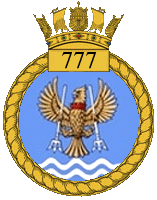Loading AI tools
Royal Navy Fleet Air Arm Squadron From Wikipedia, the free encyclopedia
777 Naval Air Squadron (777 NAS) was a Naval Air Squadron of the Royal Navy's Fleet Air Arm, which formed as a Fleet Requirements Unit in West Africa during the Second World War.[4] Throughout most of 1943, the squadron was responsible for the air defence of Sierra Leone. It disbanded at HMS Spurwing, RNAS Hastings, Sierra Leone, during December 1944. The squadron reformed in May 1945, from 'B' Flight of 778 Naval Air Squadron, as a Carrier Trials Unit operating aboard HMS Pretoria Castle, and using shore bases at HMS Siskin, RNAS Gosport, and HMS Peregrine, RNAS Ford in England, and HMS Wagtail, RNAS Ayr, in Scotland. 777 Naval Air Squadron number was assigned to the aircraft collection at the Fleet Air Arm Museum in April 2006.
| 777 Naval Air Squadron | |
|---|---|
 777 NAS badge | |
| Active | 1 August 1941 – 25 December 1944 23 May 1945 – 3 January 1946[1] |
| Country | |
| Branch | |
| Type | Fleet Air Arm Second Line Squadron |
| Role |
|
| Size | Squadron |
| Part of | Fleet Air Arm |
| Motto(s) | Expertam docemus arter (Latin for 'We teach the art which we have gained by experiment')[2] |
| Aircraft | See Aircraft operated section for full list. |
| Insignia | |
| Squadron Badge | Blue, over a base barry way of four white and blue an eagle displayed gold armed and langued red gorged with a mural crown red grasping in each talon a trident point downward whte (1945)[2] |
| Identification Markings | No markings or single letters (1941 - 1944) SA+ Defiants single letters (1945 - 1946)[3][2] |

777 Naval Air Squadron was originally planned to form on 15 December 1939, as a Reserve Fighter Pool squadron, at RNAS Eastleigh (HMS Raven), Hampshire, England and to have been equipped with Blackburn Roc, a naval fighter aircraft and Blackburn Skua, a dive bomber and fighter aircraft.[2]
777 Naval Air Squadron was formed at RAF Hastings in Sierra Leone, West Africa on 1 August 1941. This airfield was located 8 miles (13 km) south-east of the port city of Freetown, and was sited about 0.5 miles (0.80 km) north-east of the village of Hastings.[4] The squadron initially operated only Fairey Swordfish, a biplane torpedo bomber and Blackburn Roc, a naval turret fighter aircraft. However, by 1942 the squadron had acquired some Boulton Paul Defiant interceptor and target tug aircraft and Supermarine Walrus, an amphibious maritime patrol aircraft.[5][6]
Lodger facility for an R.N. Air Section on RAF station from 1 April 1940 had been granted. However, in March 1943, the control of the airfield was given over to the Admiralty and it was commissioned HMS Spurwing, and the airfield was also known as RNAS Hastings.[7] Between 1942 and 1944, the squadron flew it's Supermarine Walrus amphibious aircraft on search and rescue sorties as well as anti-submarine patrols.[8][9] During 1943, 777 Naval Air Squadron was involved with the air defence of Sierra Leone, a task which they fulfilled for most of the year.[6]

During the squadron's existence, there were several accidents in April, June and October 1944, three Target Tug Boulton Paul Defiants belonging to the squadron were written off.[clarification needed] It seems that in all three of these incidents, there were no fatalities.[10][11][12]
Sub-Lieutenant D.R. Bentley died on 9 June 1943.[13]
777 Naval Air Squadron disbanded at RNAS Hastings (HMS Spurwing), on 25 December 1944.[6][7]
The squadron was reformed on 23 May 1945 from 'B' Flight 778 Naval Air Squadron as a carrier trials unit for service aboard HMS Pretoria Castle. It used a variety of aircraft including Supermarine Seafire and de Havilland Mosquito.[1]
It was initially equipped with eight aircraft, two each of Fairey Albacore, a biplane torpedo bomber, Fairey Barracuda, a torpedo and dive bomber, Fairey Fulmar a reconnaissance and fighter aircraft and Supermarine Seafire, a navalised version of the Supermarine Spitfire fighter aircraft, but it also utilised various aircraft from 778 Naval Air Squadron. The squadrons role was to undertake trials on aircraft and aircraft carrier equipment (778 NAS was tasked with individual aircraft trials). It initially used RNAS Ayr (HMS Wagtail), South Ayrshire, Scotland as an operational shore base, followed by RNAS Ford (HMS Peregrine), Sussex, England, and then RNAS Gosport (HMS Siskin), Hampshire, England. 777 Naval Air Squadron disbanded back into 778 Naval Air Squadron on 3 January 1946.[2]
In April 2006, Rear Admiral Fleet Air Arm allocated 777 Naval Air Squadron number to the aircraft collection at the Fleet Air Arm Museum, at RNAS Yeovilton (HMS Heron), Somerset.[2]
The squadron operated a variety of different aircraft and versions:[1][14]
777 Naval Air Squadron operated from a number of naval air station of the Royal Navy, in the United Kingdom, a Royal Navy converted Escort Carrier and airbases overseas:[14]
1941 - 1944
1945 - 1946
2006 -
List of commanding officers of 777 Naval Air Squadron with day, month and year of appointment:[3]
1941 - 1944
1945 - 1946
Seamless Wikipedia browsing. On steroids.
Every time you click a link to Wikipedia, Wiktionary or Wikiquote in your browser's search results, it will show the modern Wikiwand interface.
Wikiwand extension is a five stars, simple, with minimum permission required to keep your browsing private, safe and transparent.